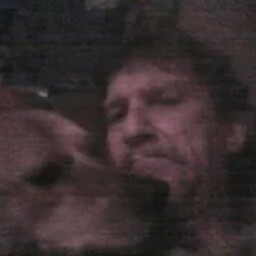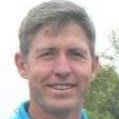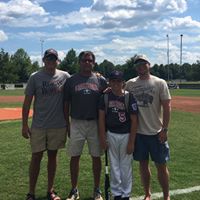Michael C Samples
age ~56
from Bellevue, WA
- Also known as:
-
- Michael E Samples
- Michael A Samples
- Patrick C Samples
- Mike C Samples
- Michaela Samples
- Patrick S
Michael Samples Phones & Addresses
- Bellevue, WA
- Anaconda, MT
- Butte, MT
- Kent, WA
- 14120 171St St, Renton, WA 98058 • 4252553467
- Kirkland, WA
- Tacoma, WA
- Kiona, WA
Us Patents
-
Object And Environment Tracking Via Shared Sensor
view source -
US Patent:20200333878, Oct 22, 2020
-
Filed:Jul 7, 2020
-
Appl. No.:16/922311
-
Inventors:- Redmond WA, US
Michael Edward SAMPLES - Redmond WA, US
Alexandru Octavian BALAN - Sammamish WA, US
William Douglas GUYMAN - Medina WA, US
Vuk JOVANOVIC - Belgrade, RS
Taras KHAPKO - Belgrade, RS
Ivan RAZUMENIC - Belgrade, RS
Vladimir CARAPIC - Belgrade, RS
Martin Thomas SHETTER - Bellevue WA, US
Jelena MOJASEVIC - Belgrade, RS
Andrew C. GORIS - Loveland CO, US
Marko BEZULJ - Belgrade, RS -
Assignee:Microsoft Technology Licensing, LLC - Redmond WA
-
International Classification:G06F 3/01
G06T 7/73
G06T 7/285
G06T 7/246
G06T 7/80
A63F 13/53
A63F 13/213
A63F 13/211
A63F 13/235
A63F 13/80
A63F 13/92
G06F 3/033
G02B 27/01
G06F 3/03
G06F 3/0481
A63F 13/31
A63F 13/212
A63F 13/42
A63F 13/22
A63F 13/428
A63F 13/24
H04N 13/246
H04N 13/239
H04N 13/254
H05B 45/10
H05B 47/11
H05B 47/19
H05B 47/105
G01C 19/5776
G01J 1/44
F21V 23/04
G06F 3/0346
G06F 3/038
G01B 11/00
G01D 5/26 -
Abstract:One disclosed example provides a head-mounted device configured to control a plurality of light sources of a handheld object and acquire image data comprising a sequence of environmental tracking exposures in which the plurality of light sources are controlled to have a lower integrated intensity and handheld object tracking exposures in which the plurality of light sources are controlled to have a higher integrated intensity. The instructions are further executable to detect, via an environmental tracking exposure, one or more features of the surrounding environment, determine a pose of the head-mounted device based upon the one or more features of the surrounding environment detected, detect via a handheld object tracking exposure the plurality of light sources of the handheld object, determine a pose of the handheld object relative to the head-mounted device based upon the plurality of light sources detected, and output the pose of the handheld object.
-
Handheld Object Pose Determinations
view source -
US Patent:20190325274, Oct 24, 2019
-
Filed:Apr 24, 2018
-
Appl. No.:15/960988
-
Inventors:- Redmond WA, US
Michael Edward SAMPLES - Redmond WA, US
Ivan RAZUMENIC - Belgrade, RS -
Assignee:Microsoft Technology Licensing, LLC - Redmond WA
-
International Classification:G06K 9/62
G06T 7/70
G06F 3/01 -
Abstract:One disclosed example provides a method for determining a pose of a handheld object in a surrounding environment. Optical pose data is stored in an image queue of a first filter. IMU data is received from an IMU of the handheld object and stored in an IMU queue of the first filter. Using at least a portion of the optical pose data and the IMU data, an initial pose of the handheld object is determined and outputted. The method determines that either the image queue or the IMU queue is empty. A second filter comprising the one empty queue and the other non-empty queue is instantiated as a copy of the first filter. Using the data from the non-empty queue in the second filter, the initial pose of the handheld object is updated to an updated pose, and the updated pose is outputted.
-
Driving An Image Capture System To Serve Plural Image-Consuming Processes
view source -
US Patent:20190012835, Jan 10, 2019
-
Filed:Jul 7, 2017
-
Appl. No.:15/643494
-
Inventors:- Redmond WA, US
Raymond Kirk PRICE - Redmond WA, US
Denis Claude Pierre DEMANDOLX - Bellevue WA, US
Michael SAMPLES - Redmond WA, US -
International Classification:G06T 19/00
G02B 27/01
G06F 3/01
G06T 19/20 -
Abstract:A technique is described herein that employs a resource-efficient image capture system. The image capture system includes an active illumination system for emitting electromagnetic radiation within a physical environment. The image capture system also includes a camera system that includes one or more cameras for detecting electromagnetic radiation received from the physical environment, to produce image information. In one implementation, the technique involves using the same image capture system to produce different kinds of image information for consumption by different respective image processing components. The technique can perform this task by allocating timeslots over a span of time for producing the different kinds of image information. In one case, the image processing components include: a pose tracking component; a controller tracking component; and a surface reconstruction component, etc., any subset of which may be active at any given time.
-
Object And Environment Tracking Via Shared Sensor
view source -
US Patent:20180329484, Nov 15, 2018
-
Filed:Nov 29, 2017
-
Appl. No.:15/826560
-
Inventors:- Redmond WA, US
Michael Edward SAMPLES - Redmond WA, US
Alexandru Octavian BALAN - Sammamish WA, US
William Douglas GUYMAN - Medina WA, US
Vuk JOVANOVIC - Belgrade, RS
Taras KHAPKO - Belgrade, RS
Ivan RAZUMENIC - Belgrade, RS
Vladimir CARAPIC - Belgrade, RS
Martin Thomas SHETTER - Bellevue WA, US
Jelena MOJASEVIC - Belgrade, RS
Andrew C. GORIS - Loveland CO, US
Marko BEZULJ - Belgrade, RS -
Assignee:Microsoft Technology Licensing, LLC - Redmond WA
-
International Classification:G06F 3/01
G06T 7/73
G06T 7/285
G06T 7/246
G06T 7/80
A63F 13/53
A63F 13/92
A63F 13/213
A63F 13/211
A63F 13/235
A63F 13/80 -
Abstract:One disclosed example provides a head-mounted device configured to control a plurality of light sources of a handheld object and acquire image data comprising a sequence of environmental tracking exposures in which the plurality of light sources are controlled to have a lower integrated intensity and handheld object tracking exposures in which the plurality of light sources are controlled to have a higher integrated intensity. The instructions are further executable to detect, via an environmental tracking exposure, one or more features of the surrounding environment, determine a pose of the head-mounted device based upon the one or more features of the surrounding environment detected, detect via a handheld object tracking exposure the plurality of light sources of the handheld object, determine a pose of the handheld object relative to the head-mounted device based upon the plurality of light sources detected, and output the pose of the handheld object.
-
Tracking Wearable Device And Handheld Object Poses
view source -
US Patent:20180329516, Nov 15, 2018
-
Filed:Nov 29, 2017
-
Appl. No.:15/826452
-
Inventors:- Redmond WA, US
Michael Edward SAMPLES - Redmond WA, US
Alexandru Octavian BALAN - Sammamish WA, US
Salim SIRTKAYA - Redmond WA, US
William Douglas GUYMAN - Medina WA, US
Vuk JOVANOVIC - Belgrade, RS
Filip PANJEVIC - Belgrade, RS -
Assignee:Microsoft Technology Licensing, LLC - Redmond WA
-
International Classification:G06F 3/03
G01B 11/00
G01D 5/26
G06F 3/01
G06F 3/0346
A63F 13/213 -
Abstract:One disclosed example provides a computing device configured to receive from an image sensor of a head-mounted device environmental tracking exposures and handheld object tracking exposures, determine a pose of the handheld object with respect to the head-mounted device based upon the handheld object tracking exposures, determine a pose of the head-mounted device with respect to a surrounding environment based upon the environmental tracking exposures, derive a pose of the handheld object relative to the surrounding environment based upon the pose of the handheld object with respect to the head-mounted device and the pose of the head-mounted device with respect to the surrounding environment, and output the pose of the handheld object relative to the surrounding environment for controlling a user interface displayed on the head-mounted device.
-
Virtual Rigid Framework For Sensor Subsystem
view source -
US Patent:20180164878, Jun 14, 2018
-
Filed:Dec 12, 2016
-
Appl. No.:15/376521
-
Inventors:- Redmond WA, US
Quentin Simon Charles Miller - Sammamish WA, US
Lev Cherkashin - Redmond WA, US
Michael Samples - Redmond WA, US
Drew Edward Steedly - Woodinville WA, US -
International Classification:G06F 3/01
G06F 3/00
G02B 27/01 -
Abstract:An apparatus for dynamically determining a displacement of a target sensor in an electronic system is disclosed. The apparatus can comprise a non-line-of-sight sensor rigidly mounted on or proximate to the target sensor and configured to measure a parameter that varies with the displacement of the target sensor. The apparatus further can comprise at least one processor coupled to the non-line-of-sight sensor and configured to compute the displacement of the target sensor based on the parameter, and to compute an adjustment value based on the computed displacement.
-
Display Active Alignment System For Waveguide Displays
view source -
US Patent:20180074317, Mar 15, 2018
-
Filed:Sep 12, 2016
-
Appl. No.:15/263212
-
Inventors:Steven John Robbins - Redmond WA, US
Drew Edward Steedly - Woodinville WA, US
Michael Edward Samples - Redmond WA, US
Zhiqiang Liu - Redmond WA, US
Andrew K. Juenger - Woodinville WA, US -
International Classification:G02B 27/01
G02B 6/42
G02B 6/293
G06T 11/00
G06T 7/00
G06T 3/00 -
Abstract:A display system includes a display alignment tracker configured track the position of a first signal and the position of a second signal. The display alignment tracker optically multiplexes a portion of a first signal and a portion of the second signal into a combined optical signal and measures a differential between the first signal and the second signal.
-
Display Active Alignment Systems Utilizing Test Patterns For Calibrating Signals In Waveguide Displays
view source -
US Patent:20180074578, Mar 15, 2018
-
Filed:Sep 12, 2016
-
Appl. No.:15/263220
-
Inventors:Steven John Robbins - Redmond WA, US
Drew Edward Steedly - Woodinville WA, US
Michael Edward Samples - Redmond WA, US
Zhiqiang Liu - Redmond WA, US
Andrew K. Juenger - Woodinville WA, US -
International Classification:G06F 3/01
G06T 11/60
G06T 11/00
G09G 3/00
G02B 27/01 -
Abstract:A display system includes a display alignment tracker configured track the position of a first signal in a first waveguide and the position of a second signal in a second waveguide. The display alignment tracker optically multiplexes a portion of a first signal and a portion of the second signal into a combined optical signal and measures a differential between the first signal and the second signal. The differential is used to adjust the position, dimensions, or a color attribute of the first signal relative to the second signal.
Name / Title
Company / Classification
Phones & Addresses
SIMPLE MECHANICS MASSAGE THERAPY, INC
Resumes

Microsoft Hololens
view sourceLocation:
16117 northeast 90Th Way, Redmond, WA 98052
Industry:
Computer Software
Work:
Toyota Technical Center - Ann Arbor, MI since May 2005
AI & Robotics Senior Engineer
Altarum May 2003 - Aug 2004
AI Research Intern
University of Michigan May 2002 - Sep 2002
Undergraduate Research
AI & Robotics Senior Engineer
Altarum May 2003 - Aug 2004
AI Research Intern
University of Michigan May 2002 - Sep 2002
Undergraduate Research
Education:
University of Michigan 2001 - 2006
B.S., Computer Science & Mathematics
B.S., Computer Science & Mathematics
Skills:
C++
Machine Learning
Computer Vision
Artificial Intelligence
Algorithms
Data Mining
Python
Robotics
Simulations
Computer Science
Camera Calibration
Slam
Probabilistic Models
R&D
Navigation
Optimization
Numerical Methods
Sensors
Autonomous Vehicles
Mountain Biking
Path Planning
R
Distributed Systems
Mapping
Augmented Reality
Virtual Reality
Machine Learning
Computer Vision
Artificial Intelligence
Algorithms
Data Mining
Python
Robotics
Simulations
Computer Science
Camera Calibration
Slam
Probabilistic Models
R&D
Navigation
Optimization
Numerical Methods
Sensors
Autonomous Vehicles
Mountain Biking
Path Planning
R
Distributed Systems
Mapping
Augmented Reality
Virtual Reality
Interests:
Kayaking
Investing
Rock Climbing
Snowboarding
Soccer
Running
Coding
Investing
Rock Climbing
Snowboarding
Soccer
Running
Coding

Michael Samples
view source
Michael Samples
view source
Michael Samples
view sourceLocation:
United States
Googleplus

Michael Samples

Michael Samples
Tagline:
How does I work this thang?

Michael Samples

Michael Samples

Michael Samples
Youtube
Myspace
Plaxo

michael samples
view sourceAI & Robotics researcher. Primarily interested in mobile robotics applications of AI algorithms.

Michael Samples
view sourceSamples Properties
Flickr
Classmates

Michael Samples
view sourceSchools:
Du Quoin High School Du Quoin IL 1975-1979
Community:
Diana Bowers, Richard Mcquinn, Dawn Hess, Glen Moore

Michael Samples
view sourceSchools:
Community High School Nevada TX 1992-1996
Community:
Kerry Porter, Jessica Wright, Robert Dawson, Alice Jones

Michael Samples
view sourceSchools:
Liberty High School Glen Daniel WV 1982-1986
Community:
Gail Farley, Bethann Godfrey

Michael Samples
view sourceSchools:
Saint Mark Lutheran School Cleveland OH 1964-1972, Lutheran High School West Rocky River OH 1973-1976
Community:
William Varga, Gail Skinner

Michael Samples
view sourceSchools:
John Carroll Catholic High Schoool Birmingham AL 1971-1975
Community:
Kathy Carden, Dennis Wiemar, Mark Calkins

Michael Samples
view sourceSchools:
Aurora High School Aurora NE 1980-1984
Community:
Mark Volf, Robin Anderson, Greg Cranfill, Clint Spiegel, Lori Wert, Jeff Nelson, Linda Luthy, Dana Duncan, Bruce Jensen

Liberty High School, Glen...
view sourceGraduates:
Michael Samples (1982-1986),
Joseph Gray (2002-2006),
Jessica Harrison (2003-2007),
Harry Collins (1995-1999),
Adolph Chacon (1991-1995)
Joseph Gray (2002-2006),
Jessica Harrison (2003-2007),
Harry Collins (1995-1999),
Adolph Chacon (1991-1995)

Carroll High School, Birm...
view sourceGraduates:
Kevin Roberts (1981-1985),
Jo Ann Deonna (1954-1958),
Michael Samples (1971-1975),
Thomas Ritchey (1994-1998)
Jo Ann Deonna (1954-1958),
Michael Samples (1971-1975),
Thomas Ritchey (1994-1998)

Michael Samples
view source
Michael Samples
view source
Michael Samples
view source
Michael A Samples
view source
Michael R. Samples
view source
Michael Joseph Samples
view source
Michael Samples
view source
Michael Samples
view sourceGet Report for Michael C Samples from Bellevue, WA, age ~56










